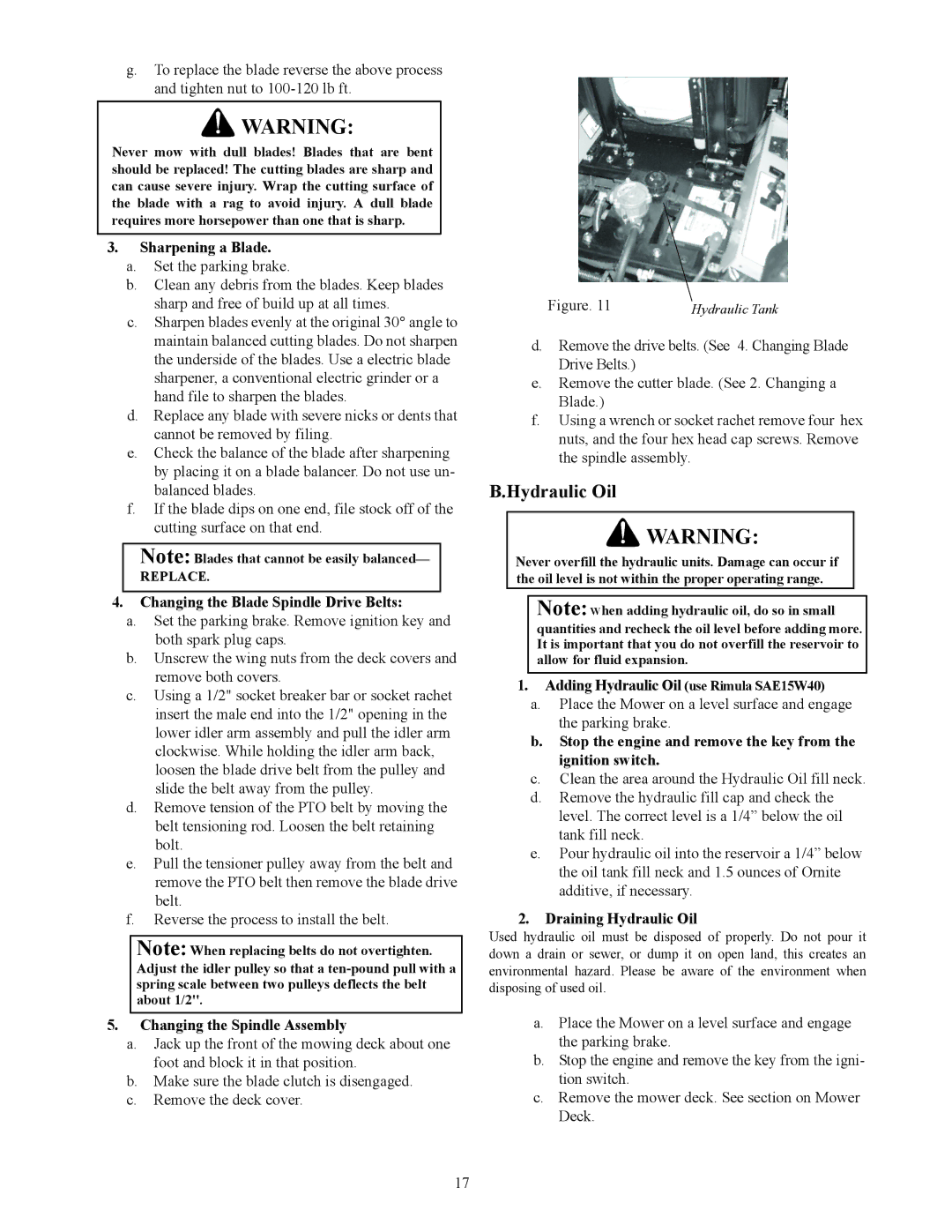
g.To replace the blade reverse the above process and tighten nut to
![]() WARNING:
WARNING:
Never mow with dull blades! Blades that are bent should be replaced! The cutting blades are sharp and can cause severe injury. Wrap the cutting surface of the blade with a rag to avoid injury. A dull blade requires more horsepower than one that is sharp.
3.Sharpening a Blade.
a.Set the parking brake.
b.Clean any debris from the blades. Keep blades sharp and free of build up at all times.
c.Sharpen blades evenly at the original 30° angle to maintain balanced cutting blades. Do not sharpen the underside of the blades. Use a electric blade sharpener, a conventional electric grinder or a hand file to sharpen the blades.
d.Replace any blade with severe nicks or dents that cannot be removed by filing.
e.Check the balance of the blade after sharpening by placing it on a blade balancer. Do not use un- balanced blades.
f.If the blade dips on one end, file stock off of the cutting surface on that end.
Note: Blades that cannot be easily balanced—
REPLACE.
4.Changing the Blade Spindle Drive Belts:
a.Set the parking brake. Remove ignition key and both spark plug caps.
b.Unscrew the wing nuts from the deck covers and remove both covers.
c.Using a 1/2" socket breaker bar or socket rachet insert the male end into the 1/2" opening in the lower idler arm assembly and pull the idler arm clockwise. While holding the idler arm back, loosen the blade drive belt from the pulley and slide the belt away from the pulley.
d.Remove tension of the PTO belt by moving the belt tensioning rod. Loosen the belt retaining bolt.
e.Pull the tensioner pulley away from the belt and remove the PTO belt then remove the blade drive belt.
f.Reverse the process to install the belt.
Note: When replacing belts do not overtighten. Adjust the idler pulley so that a
5.Changing the Spindle Assembly
a.Jack up the front of the mowing deck about one foot and block it in that position.
b.Make sure the blade clutch is disengaged.
c.Remove the deck cover.
Figure. 11 | Hydraulic Tank |
d.Remove the drive belts. (See 4. Changing Blade Drive Belts.)
e.Remove the cutter blade. (See 2. Changing a Blade.)
f.Using a wrench or socket rachet remove four hex nuts, and the four hex head cap screws. Remove the spindle assembly.
B.Hydraulic Oil
WARNING:
Never overfill the hydraulic units. Damage can occur if the oil level is not within the proper operating range.
Note: When adding hydraulic oil, do so in small quantities and recheck the oil level before adding more. It is important that you do not overfill the reservoir to allow for fluid expansion.
1.Adding Hydraulic Oil (use Rimula SAE15W40)
a.Place the Mower on a level surface and engage the parking brake.
b.Stop the engine and remove the key from the ignition switch.
c.Clean the area around the Hydraulic Oil fill neck.
d.Remove the hydraulic fill cap and check the level. The correct level is a 1/4” below the oil tank fill neck.
e.Pour hydraulic oil into the reservoir a 1/4” below the oil tank fill neck and 1.5 ounces of Ornite additive, if necessary.
2.Draining Hydraulic Oil
Used hydraulic oil must be disposed of properly. Do not pour it down a drain or sewer, or dump it on open land, this creates an environmental hazard. Please be aware of the environment when disposing of used oil.
a.Place the Mower on a level surface and engage the parking brake.
b.Stop the engine and remove the key from the igni- tion switch.
c.Remove the mower deck. See section on Mower Deck.
17
